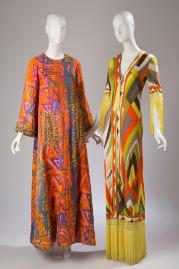The Museum at FIT will present Trend-ology, a new exhibition that examines the sources from which fashion trends have emerged over the past 250 years.

Featuring approximately 100 objects from the museum’s permanent collection, the exhibition will also highlight industry developments that have had an impact on how trends propagate.
Fashion trends change every season, with shifts in print, color, material, embellishment, and silhouette. These derive from a variety of sources, including urban street style, art, music, film, and socio-political movements. The word “trend” first arose as an economic term used to describe shifts in financial markets.
Today, the word is ubiquitous in the fashion media, and trend forecasting companies have made researching and predicting trends a profitable business. Yet, as we move further into the 21st century, specific trends seem increasingly hard to define.
The advent of fast fashion, the internet, and social media have created a quick-paced global environment in which fashion trends emerge and spread in faster and more complex ways than ever before.
By looking back at the history of trends, Trend-ology will help viewers gain insight into the current state of the trend cycle.
Trend-ology will open with an overview of 21st-century developments in fashion retailing. These will include examples from fast-fashion companies, such as Zara, H&M, and Topshop, that have contributed to the increasing fascination–and anxiety–surrounding trends.
High-low collaborations, including a “Rodarte for Target” sequined dress from 2009, will be juxtaposed with high fashion designs–in this case, a runway piece from Rodarte’s spring 2010 collection.
A selection of “It” bags, including a Louis Vuitton Speedy 30 bag designed in collaboration with Japanese artist Takeshi Murakami, will illustrate how important the sale of accessories has become to luxury brands during the new millennium.
To highlight the recent emergence of concept stores, the introductory section will culminate with ensembles from Opening Ceremony and Colette.
The exhibition’s historical chronology will begin with two 18th-century ensembles, one for a man and the other for a woman, rendered in vibrant shades of yellow.
Once negatively associated with “heretics,” yellow became a trendy color in 18th-century dress. The change in yellow’s cultural meaning can be traced to the growing popularity in Europe of chinoiserie. In China, yellow was an auspicious color associated with the emperor.
A selection of tartan dresses will show a recurring international trend for tartan dress that emerged during the 19th century from the widespread popularity of Sir Walter Scott’s Scottish-themed novels.
Starting in the mid-19th century, the pace of the trend cycle was accelerated by certain capitalist developments, such as the emergence of the couture house and the subsequent rise of the department store.
These developments will be addressed in Trend-ology with a dress, circa 1883, by couturier Charles Fredrick Worth shown alongside an ensemble from Lord & Taylor, circa 1895, and a Lord & Taylor mail-order catalogue from the same period.
A trend for Orientalism in fashion reached its zenith during the first decades of the 20th century. Typified in the designs of Paul Poiret, this interest in decorative arts and fashion, inspired by exports from Turkey, Japan, and China, lasted well into the 1920s. A suit by Poiret from 1912 will be on view.
Glamour was a significant fashion trend in the 1930s. With the onset of the Great Depression, moviegoers found escape in the glamour of Hollywood.
As a result, the shimmery bias-cut gowns worn on screen greatly influenced the fashions of the period, such as a floor-length, champagne–colored evening dress embellished with rhinestones, circa 1930, that will be featured in Trend-ology.
In the 1940s, a vogue developed in daywear for casual, brightly patterned cotton clothing designed for an active lifestyle. Pioneered by American designers Claire McCardell and Tom Brigance, this new aesthetic was dubbed “The American Look.” Examples of McCardell’s and Brigance’s work will be on view.
French couture came back full force after World War II with the trendy silhouette launched by Christian Dior’s New Look collection in 1947.
Well into the 1950s, New York-based designers such as Anne Fogarty continued to draw inspiration from Dior’s signature silhouette. To illustrate this transatlantic spread, a bright red Dior ensemble, circa 1950, will be shown alongside a circa 1954 Fogarty dress in a similar hue.
The rise of London youth culture in the 1960s served as a significant source of trends for the fashion industry as a whole.
This will be shown by a group of daringly short mini-dresses that illustrate the spread of the look from Mary Quant’s London boutique to the ready-to-wear collections of Geoffrey Beene in New York.
During this same time period, commercial air travel was becoming increasingly accessible, enabling socialites, fashion photographers, and designers alike to visit far-off locations more easily than ever before. As a result, exoticism reemerged.
The brightly colored Kaftans from Emilio Pucci and Oscar de la Renta that will be on view in Trend-ology became wardrobe essentials among the jetset.
While music has always had a large influence on fashion, this was especially true during the 1970s, when disco-fueled nightclubs, music festivals, and the underground punk scene served as ideal environments to foster fashion trends.
Halston’s slinky, silk jersey designs were perfect for moving across the dance floor at Studio 54. A particularly body-revealing jumpsuit, worn by Ethel Scull, a patron of pop and minimal art, will also be on display.
In the 1980s, conspicuous luxury became a key trend. Fashion consumers of the Reagan era cultivated a penchant for opulent embellishment, ornate textiles, and a saturated color-palette.





